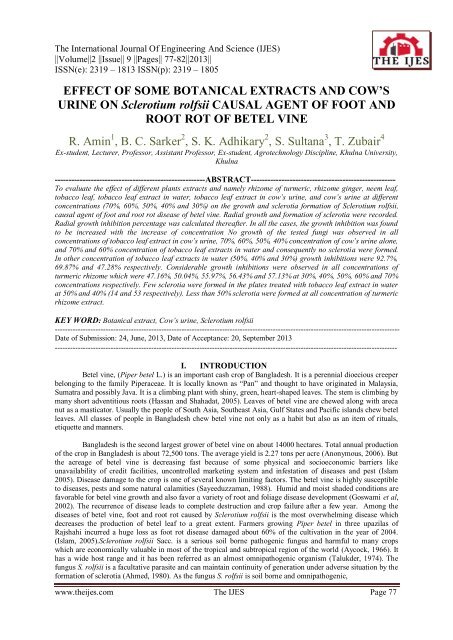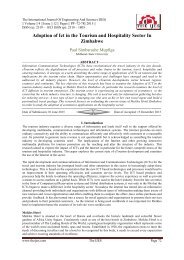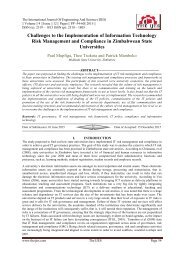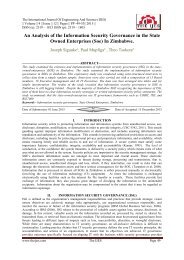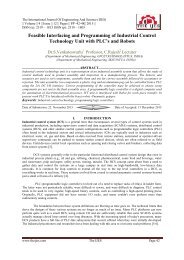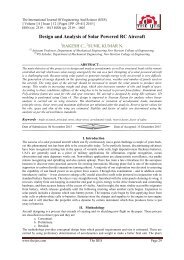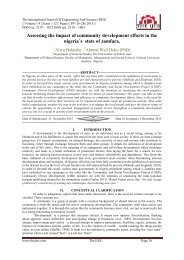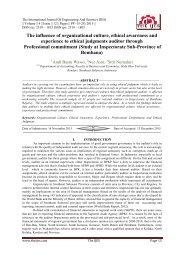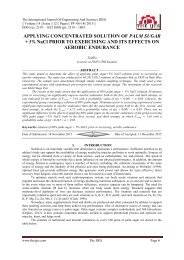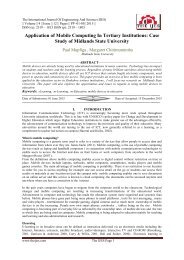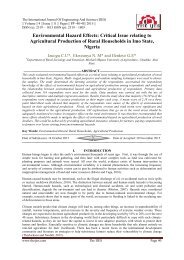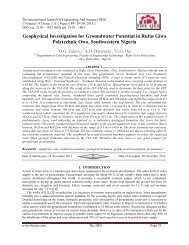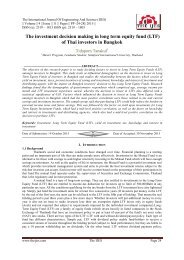The International Journal of Engineering and Science (The IJES)
The International Journal of Engineering
The International Journal of Engineering
Create successful ePaper yourself
Turn your PDF publications into a flip-book with our unique Google optimized e-Paper software.
<strong>The</strong> <strong>International</strong> <strong>Journal</strong> Of <strong>Engineering</strong> And <strong>Science</strong> (<strong>IJES</strong>)<br />
||Volume||2 ||Issue|| 9 ||Pages|| 77-82||2013||<br />
ISSN(e): 2319 – 1813 ISSN(p): 2319 – 1805<br />
EFFECT OF SOME BOTANICAL EXTRACTS AND COW’S<br />
URINE ON Sclerotium rolfsii CAUSAL AGENT OF FOOT AND<br />
ROOT ROT OF BETEL VINE<br />
R. Amin 1 , B. C. Sarker 2 , S. K. Adhikary 2 , S. Sultana 3 , T. Zubair 4<br />
Ex-student, Lecturer, Pr<strong>of</strong>essor, Assistant Pr<strong>of</strong>essor, Ex-student, Agrotechnology Discipline, Khulna University,<br />
Khulna<br />
------------------------------------------------------ABSTRACT----------------------------------------------------<br />
To evaluate the effect <strong>of</strong> different plants extracts <strong>and</strong> namely rhizome <strong>of</strong> turmeric, rhizome ginger, neem leaf,<br />
tobacco leaf, tobacco leaf extract in water, tobacco leaf extract in cow’s urine, <strong>and</strong> cow’s urine at different<br />
concentrations (70%, 60%, 50%, 40% <strong>and</strong> 30%) on the growth <strong>and</strong> sclerotia formation <strong>of</strong> Sclerotium rolfsii,<br />
causal agent <strong>of</strong> foot <strong>and</strong> root rot disease <strong>of</strong> betel vine. Radial growth <strong>and</strong> formation <strong>of</strong> sclerotia were recorded.<br />
Radial growth inhibition percentage was calculated thereafter. In all the cases, the growth inhibition was found<br />
to be increased with the increase <strong>of</strong> concentration No growth <strong>of</strong> the tested fungi was observed in all<br />
concentrations <strong>of</strong> tobacco leaf extract in cow’s urine, 70%, 60%, 50%, 40% concentration <strong>of</strong> cow’s urine alone,<br />
<strong>and</strong> 70% <strong>and</strong> 60% concentration <strong>of</strong> tobacco leaf extracts in water <strong>and</strong> consequently no sclerotia were formed.<br />
In other concentration <strong>of</strong> tobacco leaf extracts in water (50%, 40% <strong>and</strong> 30%) growth inhibitions were 92.7%,<br />
69.87% <strong>and</strong> 47.28% respectively. Considerable growth inhibitions were observed in all concentrations <strong>of</strong><br />
turmeric rhizome which were 47.16%, 50.04%, 55.97%, 56.43% <strong>and</strong> 57.13% at 30%, 40%, 50%, 60% <strong>and</strong> 70%<br />
concentrations respectively. Few sclerotia were formed in the plates treated with tobacco leaf extract in water<br />
at 50% <strong>and</strong> 40% (14 <strong>and</strong> 53 respectively). Less than 50% sclerotia were formed at all concentration <strong>of</strong> turmeric<br />
rhizome extract.<br />
KEY WORD: Botanical extract, Cow’s urine, Sclerotium rolfsii<br />
----------------------------------------------------------------------------------------------------------------------------------------<br />
Date <strong>of</strong> Submission: 24, June, 2013, Date <strong>of</strong> Acceptance: 20, September 2013<br />
---------------------------------------------------------------------------------------------------------------------------------------<br />
I. INTRODUCTION<br />
Betel vine, (Piper betel L.) is an important cash crop <strong>of</strong> Bangladesh. It is a perennial dioecious creeper<br />
belonging to the family Piperaceae. It is locally known as “Pan” <strong>and</strong> thought to have originated in Malaysia,<br />
Sumatra <strong>and</strong> possibly Java. It is a climbing plant with shiny, green, heart-shaped leaves. <strong>The</strong> stem is climbing by<br />
many short adventitious roots (Hassan <strong>and</strong> Shahadat, 2005). Leaves <strong>of</strong> betel vine are chewed along with areca<br />
nut as a masticator. Usually the people <strong>of</strong> South Asia, Southeast Asia, Gulf States <strong>and</strong> Pacific isl<strong>and</strong>s chew betel<br />
leaves. All classes <strong>of</strong> people in Bangladesh chew betel vine not only as a habit but also as an item <strong>of</strong> rituals,<br />
etiquette <strong>and</strong> manners.<br />
Bangladesh is the second largest grower <strong>of</strong> betel vine on about 14000 hectares. Total annual production<br />
<strong>of</strong> the crop in Bangladesh is about 72,500 tons. <strong>The</strong> average yield is 2.27 tons per acre (Anonymous, 2006). But<br />
the acreage <strong>of</strong> betel vine is decreasing fast because <strong>of</strong> some physical <strong>and</strong> socioeconomic barriers like<br />
unavailability <strong>of</strong> credit facilities, uncontrolled marketing system <strong>and</strong> infestation <strong>of</strong> diseases <strong>and</strong> pest (Islam<br />
2005). Disease damage to the crop is one <strong>of</strong> several known limiting factors. <strong>The</strong> betel vine is highly susceptible<br />
to diseases, pests <strong>and</strong> some natural calamities (Sayeeduzzaman, 1988). Humid <strong>and</strong> moist shaded conditions are<br />
favorable for betel vine growth <strong>and</strong> also favor a variety <strong>of</strong> root <strong>and</strong> foliage disease development (Goswami et al,<br />
2002). <strong>The</strong> recurrence <strong>of</strong> disease leads to complete destruction <strong>and</strong> crop failure after a few year. Among the<br />
diseases <strong>of</strong> betel vine, foot <strong>and</strong> root rot caused by Sclerotium rolfsii is the most overwhelming disease which<br />
decreases the production <strong>of</strong> betel leaf to a great extent. Farmers growing Piper betel in three upazilas <strong>of</strong><br />
Rajshahi incurred a huge loss as foot rot disease damaged about 60% <strong>of</strong> the cultivation in the year <strong>of</strong> 2004.<br />
(Islam, 2005).Sclerotium rolfsii Sacc. is a serious soil borne pathogenic fungus <strong>and</strong> harmful to many crops<br />
which are economically valuable in most <strong>of</strong> the tropical <strong>and</strong> subtropical region <strong>of</strong> the world (Aycock, 1966). It<br />
has a wide host range <strong>and</strong> it has been referred as an almost omnipathogenic organism (Talukder, 1974). <strong>The</strong><br />
fungus S. rolfsii is a facultative parasite <strong>and</strong> can maintain continuity <strong>of</strong> generation under adverse situation by the<br />
formation <strong>of</strong> sclerotia (Ahmed, 1980). As the fungus S. rolfsii is soil borne <strong>and</strong> omnipathogenic,<br />
www.theijes.com <strong>The</strong> <strong>IJES</strong> Page 77
Effect Of Some Botanical Extracts…<br />
It is very difficult to control even by the use <strong>of</strong> chemical fungicide. Moreover, most <strong>of</strong> the chemicals<br />
are costly so the farmers have to spend a large amount <strong>of</strong> money to buy these chemicals. Now-a-days use <strong>of</strong><br />
chemical for management <strong>of</strong> crop disease is being discouraged due to health hazards <strong>and</strong> environmental<br />
pollution. So, control <strong>of</strong> the pathogen through botanical pesticides or plant extracts <strong>and</strong> natural biocides might<br />
be a good alternative. Botanical extracts are biodegradable (Devlin <strong>and</strong> Zettel, 1999) <strong>and</strong> their use in crop<br />
protection is a practical sustainable alternative. It reduces environmental contamination <strong>and</strong> health hazards<br />
(Grange <strong>and</strong> Ahmed, 1988). Research on the active ingredients, fungicide preparation, application rates <strong>and</strong><br />
environmental impact <strong>of</strong> botanical fungicides is a prerequisite (Buss <strong>and</strong> Park, 2002) for sustainable agriculture.<br />
Botanical fungicides are unique because they can be produced easily by the farmers <strong>and</strong> small industries (Roy et<br />
al., 2005). Few works have been done by using tobacco, neem, garlic <strong>and</strong> some other plant extracts to control<br />
some other fungi. Different natural biocides also used separately or in combination with plant extracts to control<br />
some other fungi by the farmers. Antifungal activities <strong>of</strong> garlic, neem, allam<strong>and</strong>a have been reported by many<br />
researchers (Islam, 2005; Rahman et al., 1999; Arun et al., 1995 <strong>and</strong> Mohanty et al., 1995).It is thus dire<br />
necessity to work extensively to examine the effect <strong>of</strong> different concentration <strong>of</strong> tobacco, neem, garlic <strong>and</strong> other<br />
indigenous plant extract <strong>and</strong> natural biocides like ginger, turmeric, cow’s urine etc. in controlling disease which<br />
are easily available. <strong>The</strong>se botanical pesticides are affordable by low income farmers <strong>and</strong> they have the<br />
potentiality for use in agriculture, especially with the dramatic increase towards the consumption <strong>of</strong> organically<br />
produced plants <strong>and</strong> ensure the sound ecology <strong>and</strong> friendly environment without any pollution. So, the present<br />
experiment was undertaken to study the effect <strong>of</strong> some botanical extracts in water <strong>and</strong> cow’s urine <strong>and</strong> cow’s<br />
urine alone on the growth <strong>and</strong> sclerotia formation <strong>of</strong> S. rolfsii in vitro.<br />
II. MATERIALS AND METHOD<br />
<strong>The</strong> experiment was conducted in the plant protection laboratory <strong>of</strong> Agrotechnology Discipline, Khulna<br />
University, Khulna to evaluate the effect <strong>of</strong> different botanical extracts namely rhizome <strong>of</strong> turmeric, rhizome <strong>of</strong><br />
ginger, neem leaf, tobacco leaf in water (soaked tobacco leaf in water for 24 hours), tobacco leaf in cow’s urine<br />
(soaked tobacco leaf in cows urine for24 hours), <strong>and</strong> cows urine at different concentrations (30%, 40%, 50%,<br />
60%, <strong>and</strong> 70%) on the growth <strong>and</strong> sclerotia formation <strong>of</strong> S. rolfsii, causal agent foot <strong>and</strong> root rot disease <strong>of</strong> betel<br />
vine. In this experiment the crude extracts <strong>of</strong> the above indigenous plants <strong>and</strong> cows urine along with the crude<br />
extract <strong>of</strong> the selected indigenous plants extract were mixed with Potato Dextrose Agar (PDA) medium at<br />
different concentrations <strong>and</strong> the fungal mycelia were inoculated here to grow. <strong>The</strong> p H <strong>of</strong> the medium was<br />
adjusted to 6.5 by using p H meter with the help <strong>of</strong> 1N HCl or 1N NaOH. Data on the radial growth <strong>and</strong> number<br />
<strong>of</strong> sclerotia were recorded from there. <strong>The</strong> fungus S. rolfsii was collected from fungal isolates preserved in the<br />
plant protection laboratory <strong>of</strong> Agrotechnology Discipline, Khulna University. Botanical extracts were prepared<br />
by using a newly adapted method following the st<strong>and</strong>ard procedure (Vijayalakshmi et al., 1999). Following<br />
materials were required for the preparation <strong>of</strong> botanical extracts- tobacco leaves, neem leaves, rhizome <strong>of</strong><br />
turmeric, rhizome <strong>of</strong> ginger, <strong>and</strong> cows urine, conical flask, beaker, soap, detergent, water, glass beaker,<br />
measuring cylinder, blender, grinding stone <strong>and</strong> h<strong>and</strong> sprayer.<strong>The</strong> basic PDA medium was modified by using<br />
the crude extracts <strong>and</strong> natural biocides <strong>of</strong> turmeric, ginger, neem, tobacco leaves in water, tobacco leaves in<br />
cow’s urine <strong>and</strong> cow’s urine at specified concentrations. <strong>The</strong> p H <strong>of</strong> the medium was adjusted to 6.5. <strong>The</strong> plates<br />
were inoculated 5mm discs <strong>of</strong> 36 hours old PDA culture <strong>and</strong> the plates were incubated at 26±2 0 C. <strong>The</strong> radial<br />
growths <strong>of</strong> mycelium <strong>and</strong> colony characters in each plate were recorded after 60 hours <strong>of</strong> incubation. After 60<br />
hours <strong>of</strong> incubation, radial growth (cm) <strong>of</strong> S. rolfsii in petridishes was recorded. <strong>The</strong> radial growth (cm) <strong>of</strong><br />
mycelium <strong>of</strong> each plate was measured by taking average <strong>of</strong> the two diameters taken right angles for each colony<br />
<strong>and</strong> then these plates were kept for 30 days for sclerotia formation.<br />
Percentage inhibition <strong>of</strong> growth was calculated using the following formula:<br />
x-y<br />
% Inhibition = X 100<br />
X<br />
Where, x = Average growth (cm) <strong>of</strong> S. rolfsii in control petridishes.<br />
y= Average growth (cm) <strong>of</strong> S. rolfsii in each plant extract <strong>and</strong> biocides treated petridishes.<br />
After 30 days the sclerotia <strong>of</strong> each petridish were separated by using camel hair brush <strong>and</strong> number <strong>of</strong> sclerotia <strong>of</strong><br />
each petridish was counted manually. Here a petridish was maintained as control to compare it with others.<br />
www.theijes.com <strong>The</strong> <strong>IJES</strong> Page 78
Effect Of Some Botanical Extracts…<br />
III. RESULTS AND DISCUSSION<br />
Effect <strong>of</strong> different plant extracts <strong>and</strong> cow’s urine on mycelial growth <strong>of</strong> S. rolfsii at different<br />
concentration<br />
<strong>The</strong> different plant extracts <strong>and</strong> cow’s urine in different concentration inhibited the mycelial growth <strong>of</strong> S. rolfsii<br />
significantly (p
Effect Of Some Botanical Extracts…<br />
<strong>The</strong> number <strong>of</strong> sclerotia produced at different concentration <strong>of</strong> tobacco leaf in water was significantly decreased<br />
with the increase <strong>of</strong> concentration (Table 2). <strong>The</strong> number <strong>of</strong> sclerotia produced at different concentration varied<br />
significantly. No sclerotia were formed at 70% <strong>and</strong> 60% concentration. Only 14 sclerotia were formed at 50%<br />
concentration followed by 40% (53) <strong>and</strong> 30% (147) <strong>and</strong> they differed significantly (p
Effect Of Some Botanical Extracts…<br />
(30%) (Table 2). <strong>The</strong> highest number <strong>of</strong> sclerotia (489) was formed in ginger rhizome extracts <strong>and</strong> the lowest<br />
number <strong>of</strong> sclerotia (147) in tobacco leaf in water but no sclerotia formed in tobacco leaf in cow’s urine.<br />
<strong>The</strong> number <strong>of</strong> sclerotia formation was significantly differing on different plant extracts <strong>and</strong> cow’s urine at a<br />
specific concentration (40%) (Table 2). <strong>The</strong> highest number <strong>of</strong> sclerotia (479) was formed in ginger rhizome<br />
extracts. <strong>The</strong> lowest number <strong>of</strong> sclerotia (53) in tobacco leaf in water. <strong>The</strong>re were no sclerotia formed in cow’s<br />
urine <strong>and</strong> tobacco leaf in cow’s urine. <strong>The</strong> number <strong>of</strong> sclerotia formation was significantly differing on different<br />
plant extracts <strong>and</strong> cow’s urine at a specific concentration (50%) (Table 2). <strong>The</strong> highest number <strong>of</strong> sclerotia (407)<br />
was formed in neem leaf extracts which was statistically similar (402) to ginger rhizome extract <strong>and</strong> the lowest<br />
number <strong>of</strong> sclerotia (14) in tobacco leaf in water. No sclerotia were formed in cow’s urine <strong>and</strong> tobacco leaf in<br />
cow’s urine. <strong>The</strong> number <strong>of</strong> sclerotia formation was significantly differing on different plant extracts <strong>and</strong> cow’s<br />
urine at a specific concentration (60%) (Table 2). <strong>The</strong> highest number <strong>of</strong> sclerotia (404) was formed in neem<br />
leaf extracts <strong>and</strong> lowest number <strong>of</strong> sclerotia (260) in turmeric rhizome extract. <strong>The</strong>re were no sclerotia formed in<br />
tobacco leaf in water, cow’s urine <strong>and</strong> tobacco leaf in cow’s urine. <strong>The</strong> number <strong>of</strong> sclerotia formation was<br />
significantly differing on different plant extracts <strong>and</strong> cows urine at a specific concentration (70%) (Table 2). <strong>The</strong><br />
highest number <strong>of</strong> sclerotia (402) was formed in neem leaf extract <strong>and</strong> the lowest numbers <strong>of</strong> sclerotia (255) in<br />
ginger rhizome extract which was statistically similar to turmeric rhizome extract (255). <strong>The</strong>re were no sclerotia<br />
formed in tobacco leaf in water, cow’s urine <strong>and</strong> tobacco leaf in cow’s urine.<br />
Table 2. Effect <strong>of</strong> different botanical extracts <strong>and</strong> cows urine at different concentration on sclerotia formation <strong>of</strong><br />
S. rolfsii<br />
Plant extract <strong>and</strong> cow’s urine Number <strong>of</strong> sclerotia at different concentration<br />
30% 40% 50% 60% 70% Control<br />
Ginger rhizome 489 b 479 b 402 cd 324 e 255 f<br />
Turmeric rhizome 277 f 269 f 267 f 260 f 255 f<br />
Neem leaf 435 c 427 c 407 cd 404 cd 402 cd<br />
Tobacco leaf in water 147 g 53 h 14 i 00 i 00 i<br />
Tobacco leaf in cow’s urine 00 i 00 i 00 i 00 i 00 i<br />
Cow’s urine 379 d 00 i 00 i 00 i 00 i<br />
CV (%) 8.34<br />
Percent inhibition<br />
120<br />
100<br />
80<br />
60<br />
40<br />
20<br />
0<br />
Means followed by a different letters are significantly different at 1% level<br />
Ginger Turmeric Neem Tobacco in water<br />
y = 1.355x + 14.18<br />
R² = 0.869<br />
y = 0.213x + 43.68<br />
R² = 0.680<br />
Fig 1: Functional relationship between concentrations <strong>and</strong> mycelial growth inhibition percentage<br />
www.theijes.com <strong>The</strong> <strong>IJES</strong> Page 81<br />
543 a<br />
y = 0.543x - 5.277<br />
R² = 0.881<br />
y = 0.176x + 2.142<br />
R² = 0.911<br />
0 20<br />
Different<br />
40<br />
concentration<br />
60 80
Number <strong>of</strong> sclerotia<br />
700<br />
600<br />
500<br />
400<br />
300<br />
200<br />
100<br />
0<br />
-100<br />
-200<br />
Effect Of Some Botanical Extracts…<br />
Ginger Turmeric Neem Tobacco in water<br />
Fig 2: Functional relationship between concentrations <strong>and</strong> formation <strong>of</strong> sclerotia<br />
y = -2.018x + 520.4<br />
R² = 0.863<br />
y = -4.090x + 585.7<br />
R² = 0.859<br />
y = -3.920x + 475.1<br />
R² = 0.735<br />
0 20 40 60 80<br />
y = -7.884x + 454.7<br />
R² = 0.856<br />
Different concentration<br />
IV. CONCLUSION<br />
For all the plant extracts <strong>and</strong> cow’s urine, mycelial growth inhibition was increased <strong>and</strong> sclerotia<br />
formation was decreased with the increase <strong>of</strong> concentration. In the specific plant extracts <strong>and</strong> natural biocides<br />
tobacco leaf extract in cow’s urine was more effective in both <strong>of</strong> mycelial growth inhibition <strong>and</strong> sclerotia<br />
formation.<br />
V. REFERENCES<br />
[1] Ahmed, F. 1980. Control <strong>of</strong> foot <strong>and</strong> root rot disease <strong>of</strong> wheat. A M.Sc. thesis submitted to Plant Pathology<br />
Department,Bangladesh Agricultural University (BAU), Mymensingh.<br />
[2] Anonymous, 2006.Asiatic society <strong>of</strong> Bangladesh.Arun, A. C., Tekha <strong>and</strong> A. Chitra.1995. Effects <strong>of</strong> alicin <strong>of</strong> garlic extract <strong>and</strong><br />
Bigonia on two fungi. Indian J. Mycol. Plant<br />
[3] Path. 2593): 316-318.<br />
[4] Aycock, R. 1966. Stem rot <strong>and</strong> other diseases caused by Sclerotium rolfsii. North Carolina Agricultural experiment Station<br />
[5] Technical Biulletin, 2: 174-202.<br />
[6] Buss, E. A. <strong>and</strong> Park, S. G. 2002. <strong>Journal</strong> <strong>of</strong> Natural Products for Insect Pest Management. 10(4): 311-318.<br />
[7] Delvin, J. F. <strong>and</strong> Zettel, T. 1999. Eco-agriculture: Initiatives in Eastern <strong>and</strong> Southern Africa. 6(2): 150-152.<br />
[8] Goswami, B. K., K. A. Kader, S. K. Adhikary, M. R. Islam, K. G. Quddus <strong>and</strong> P. K. Malaker. 2002. Severity <strong>of</strong> leaf rot <strong>of</strong><br />
[9] betel vine (Piper betel L.) through the year. Bangladesh J. <strong>of</strong> Agril. Res. 27(3): 497-501.<br />
[10] Grange, N. <strong>and</strong> Ahmed, S. 1988. H<strong>and</strong>book <strong>of</strong> Plants with Pest Cpntrol Properties. 7(5): 75-78.<br />
[11] Hassan, S. A. <strong>and</strong> Shahat , S. 2005. Diseases affecting betelvine. 3(2):4-5.<br />
[12] Islam, M. 2005. Country news, Holiday Publication Limited, 8: 3-4.<br />
[13] Mohanty, A. K., A. K. Kar <strong>and</strong> P. N. Setti. 1995. Efficacy <strong>of</strong> crude plant extracts <strong>of</strong> some selected plants in controlling<br />
[14] brinjal blight <strong>and</strong> fruit rot pathogen, Phomopsis vexans. Crop Research Hisar., 9(3): 447-448.<br />
[15] Rahman, G. M. M., M. R. Islam <strong>and</strong> M. A. Wadud. 1999. Seed treatment with plant extracts <strong>and</strong> hot water: a potential<br />
[16] biophysical method <strong>of</strong> controlling seed borne infection <strong>of</strong> wheat. Bangladesh J. Training Develop. 12(1-2): 185-190.<br />
[17] Roy, B., Amin, R., Uddin, M. N., Islam A. T. M. S., Islam, M. J. <strong>and</strong> Halder, B. C. 2005. Leaf extracts <strong>of</strong> Shiyalmutra<br />
[18] (Blumea lacera) as botanical pesticides against lesser grain borer <strong>and</strong> rice weevile. <strong>Journal</strong> <strong>of</strong> Biological <strong>Science</strong>s, 5(2): 201-204.<br />
[19] Sayeduzzaman, M. 1988. An economic geographical study <strong>of</strong> betel leaf cultivation in Bangladesh. A M.Sc. thesis submitted<br />
[20] to Department <strong>of</strong> Geography, University <strong>of</strong> Dhaka.<br />
[21] Talukder, M. 1974. Plant diseases in Bangladesh. Bangladesh J. <strong>of</strong>. Agril. Res.1(1): 64-68.<br />
[22] Vijayalakshmi, K., Subhashini, B., Koul, S. 1999. plants in pest Control, pongam, tulasi <strong>and</strong> aloe. Centre for Indian<br />
[23] Knowledge Systems, Chennai, India.<br />
www.theijes.com <strong>The</strong> <strong>IJES</strong> Page 82


